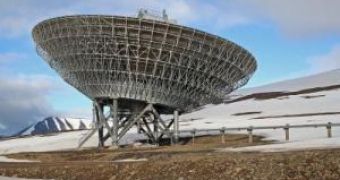And as if we weren't all full of advertisements, someone had the bright idea to broadcast one into space. The campaign was initiated by the University of Leicester and is called Doritos 'You Make It, We Play It', which basically means that some lads in the United Kingdom will have the opportunity to create a 30 second advertisement in which to describe how they perceive the life on our planet. At the end of the pre-selection, one ad will be chosen to be beamed all across the Universe, just in case somebody out there is listening. Hopefully we won't interrupt some show they like, like TV broadcasters do here on Earth.
Additionally, the human race will again have the opportunity to view yet another ad. The video signal will be sent into space on the 12th of June, with the help of the 500MHz Ultra High Frequency Radar located at the EISCAT Space Center in Svalbard, in the Arctic Ocean, more precisely in a location between Norway and the geographic North Pole. The antenna of the radar facility will point directly to a solar system lying 42 light years from Earth, in the Great Bear Constellation. The central star of the system, 47 Ursae Majoris, or 47 UMa, is a star rather similar to our Sun and might be home to small rocky planets such as our own, which could possibly support life.
The total power of the transmission will reach a peak of two thousand million watts, meaning that, if intelligent life exists within the narrow path of the signal, one living a few hundred light years from Earth will be able to receive it. After only five and a half hours, the broadcast will pass the furthest body in the solar system, Pluto, out into interstellar space.
However, unlike the radio and television transmission we've been unintentionally sending into space for the last 6 decades, this ad will be digitized, thus encoded in binary code, for sufficiently intelligent beings to decode and play it. The reason for this is simple, the signal encoded in binary is more powerful and easy to recover than simple radio transmissions.
Whether intelligent life exists or not on 47 UMa, we'll find out for certain in about a century. Just a few months ago, NASA approached a similar procedure when it broadcast one of the Beatles songs into space, thus targeting the Polaris system lying 1,000 light years away. The possibility that the signal will reach the Polaris star is rather remote, so is the existence of life in the respective system.

 14 DAY TRIAL //
14 DAY TRIAL //